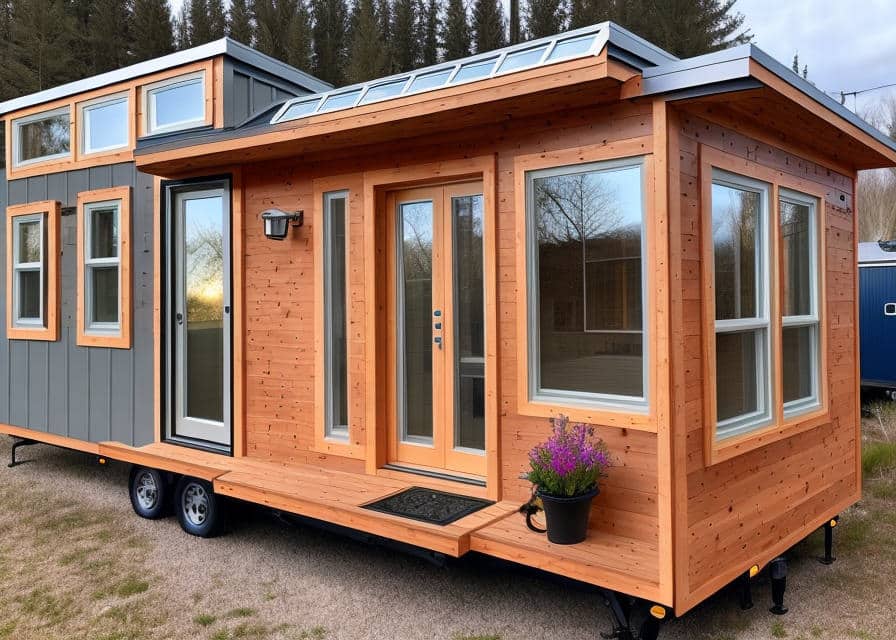Table of Contents
Introduction
A tiny house is a small dwelling that is typically less than 500 square feet. These homes are becoming increasingly popular due to their low cost, mobility, and minimal environmental impact. Installing a solar system in your tiny house can provide many benefits, including saving money on energy costs and reducing your carbon footprint. This article will explain the process of installing a solar system for your tiny house, from calculating your electricity needs to deciding if you want to be off-grid or connected to the local electrical grid. It will also cover ground solar panels and budget considerations.
Definition of Tiny House
Tiny houses are dwellings that are much smaller than traditional homes. They typically range from 100-500 square feet and are designed with efficiency in mind. Many people choose to live in tiny houses because they are cheaper than traditional homes, more mobile, and require fewer resources to build and maintain.
Benefits of Solar System Installation for Tiny Houses
Installing a solar system in your tiny house can provide many benefits. It can save you money on energy costs by reducing your reliance on the local electrical grid. It can also reduce your carbon footprint since it produces clean, renewable energy from natural sources like sunlight. Additionally, it can increase the value of your home since it will be more energy efficient than one without a solar system installed.
Calculating Your Electricity Needs
When it comes to installing a solar system for a tiny house, one of the most important steps is calculating your electricity needs. To do this, you’ll need to create an inventory of all the devices and appliances that you need to power. This list should include things like lights, TVs, kitchen appliances, and any other electrical items that you plan on using in your home.
Watt Hours
Once you have a list of all the devices and appliances that you need to power, you’ll want to consider watt hours. Watt hours measure how much electricity is used per hour by each device or appliance. This will give you an idea of how much energy your tiny house will need in order to run everything properly. To track usage more accurately, you can also use an electricity usage monitor.
Decide If You Want to Be Off-Grid or Connected to the Local Electrical Grid
You’ll also need to decide if you want your tiny house to be off-grid or connected to the local electrical grid. Each option has its own advantages and disadvantages. Going off-grid will require more upfront costs but could save money in the long run as there are no utility bills associated with it. On the other hand, being connected to the grid requires less upfront costs but could end up costing more over time due to utility bills.
Ground Solar Panels
When it comes time to install solar panels for your tiny house, you’ll want to scout out an area that gets plenty of sunlight for them. Consider the size and shape of your home when deciding where exactly they should go so that they can get optimal sunlight exposure throughout the day.
Consider Your Budget
Finally, consider your budget when looking into installing a solar system for your tiny house. There are many costs associated with this investment such as purchasing solar panels and hiring professionals for installation services. Fortunately, there are financing options available that can make converting easier on your wallet.
Decide If You Want to Be Off-Grid or Connected to the Local Electrical Grid
When it comes to solar system installation for tiny houses, one of the key decisions that you need to make is whether you want to be off-grid or connected to the local electrical grid. Each option has its own advantages and disadvantages, so it’s important to weigh all of them before making your decision.
Advantages and Disadvantages of Each Option
The main advantage of going off-grid is that you won’t have any utility bills associated with electricity usage. This can be a great way to save money if you’re living in a tiny house full time. However, it also means that you’ll need to invest in more expensive equipment upfront since you won’t be able to draw energy from the grid when needed. Additionally, if your solar panels don’t produce enough energy, then you may not have enough power for all of your appliances and devices.
On the other hand, being connected to the grid can be more expensive upfront since you’ll need additional equipment like an inverter and batteries. However, it also provides more flexibility since you can draw energy from the grid when needed. Additionally, if your solar panels produce excess energy, then you can sell it back to the utility company for a profit.
More Upfront Costs If Connected To Grid
It’s important to note that if you decide to connect your tiny house to the local electrical grid, then there will likely be additional costs associated with doing so. This includes installation fees for connecting your home as well as any permits required by your local government. Additionally, some utility companies may also require a minimum amount of energy produced before they will allow connection.
Overall, deciding whether or not to go off-grid or connect your tiny house to the local electrical grid depends on several factors including budget and personal preference. It’s important to weigh all of these factors carefully before making a decision so that you can get the most out of your solar system installation investment.
Ground Solar Panels
Ground solar panels are an effective way to power a tiny house, as they can be used to convert the sun’s energy into electricity. When deciding where to install ground solar panels, it is important to scout out an area that will get plenty of sunlight. This means avoiding any trees or large structures that could block the sun’s rays and reduce the amount of energy produced by the solar panel system. It is also important to consider the size and shape of your tiny house when deciding where to put them, as you want to make sure they are placed in a location that will best suit your home’s needs.
Finding an Ideal Location
When searching for an ideal location for ground solar panels, it is important to pay attention to how much sunlight it gets throughout the day. This means looking for a spot that receives direct sunlight during peak hours and avoiding any shade from trees or other structures. Additionally, you should look for a spot that has good drainage so that no water accumulates around the panels. You may also want to consider installing them on a roof or on top of a pole if there is limited space available on the ground.
Installation Costs
The cost associated with installing ground solar panels can vary depending on factors such as type of panel, size, and installation costs. Generally speaking, installing ground solar panels can be more expensive than rooftop systems due to additional labor costs associated with digging trenches and laying cables underground. Additionally, you may need to purchase additional equipment such as mounting brackets and wiring supplies in order to properly install the system.
Maintenance Requirements
Ground solar panels require very little maintenance once they are installed correctly. However, it is important to periodically check for any damage or debris that could be blocking the sun’s rays from reaching the panels and reducing their efficiency. It is also important to keep the area around them clean so that dust does not accumulate on them over time and reduce their performance.
Overall, ground solar panels are an effective way to power a tiny house and provide you with a reliable source of renewable energy. By carefully selecting an ideal location for installation and considering all associated costs beforehand, you can ensure that your system functions optimally for years to come.
|
Factor
|
Description
|
|
Location
|
Direct sunlight during peak hours, good drainage, no shade from trees or other structures.
|
|
Installation Costs
|
Type of panel, size, labor costs for digging trenches and laying cables underground.
|
|
Maintenance Requirements
|
Periodically check for damage or debris, keep area around panels clean.
|
Consider Your Budget
When considering the cost of installing a solar system in your tiny house, it is important to remember that it is an investment. The initial cost may be high, but the long-term savings and environmental benefits make it worth the effort. The cost associated with solar system installation can vary depending on the size of the system and type of equipment used. Generally speaking, you should expect to pay anywhere from $10,000-$20,000 for a complete installation.
Cost Associated With Solar System Installation Investment
The cost of installing a solar system in your tiny house will include the cost of purchasing all the necessary equipment such as panels, inverters, charge controllers, batteries and wiring. It will also include labor costs for installation and any additional materials needed for mounting or connecting to existing electrical systems. Depending on where you live, you may also be eligible for state or federal tax credits or incentives which can help offset some of these costs.
Financing Options Available To Make Converting Easier
If you’re looking for ways to make converting to a solar system more affordable, there are several financing options available. Many companies offer financing plans that allow you to purchase the equipment upfront and then pay it off over time with low monthly payments. Additionally, some states may offer loan programs specifically designed for homeowners who want to convert their homes to renewable energy sources like solar power.
Ultimately, deciding whether or not to convert your tiny house to a solar-powered one is a personal decision that comes down to weighing the pros and cons based on your individual needs and budget constraints. If done correctly, however, installing a solar system in your tiny home can provide significant savings over time while helping reduce your carbon footprint at the same time.
Main Idea: Investing in a solar system for a tiny house can be expensive, but there are financing options available to make it more affordable. Key findings: initial cost of up to $20,000; labor and materials costs; eligible for tax credits/incentives; financing plans available; loan programs offered in some states.
Conclusion
Installing a solar system in your tiny house is a great way to reduce your electricity bill and help the environment. The process of calculating your electricity needs, deciding if you want to be off-grid or connected to the local electrical grid, and considering your budget are all important steps in making sure you get the most out of your solar system installation. To ensure success, it is important to create a list of devices and appliances that need power, understand watt hours to calculate electricity usage per hour, use an electricity monitor to track usage, scout out an area with plenty of sunlight for panels, and consider the size and shape of your home when deciding where to put them. Additionally, it is important to factor in the cost associated with this investment as well as any financing options available. With these considerations in mind, you can make an informed decision about installing a solar system for your tiny house.


